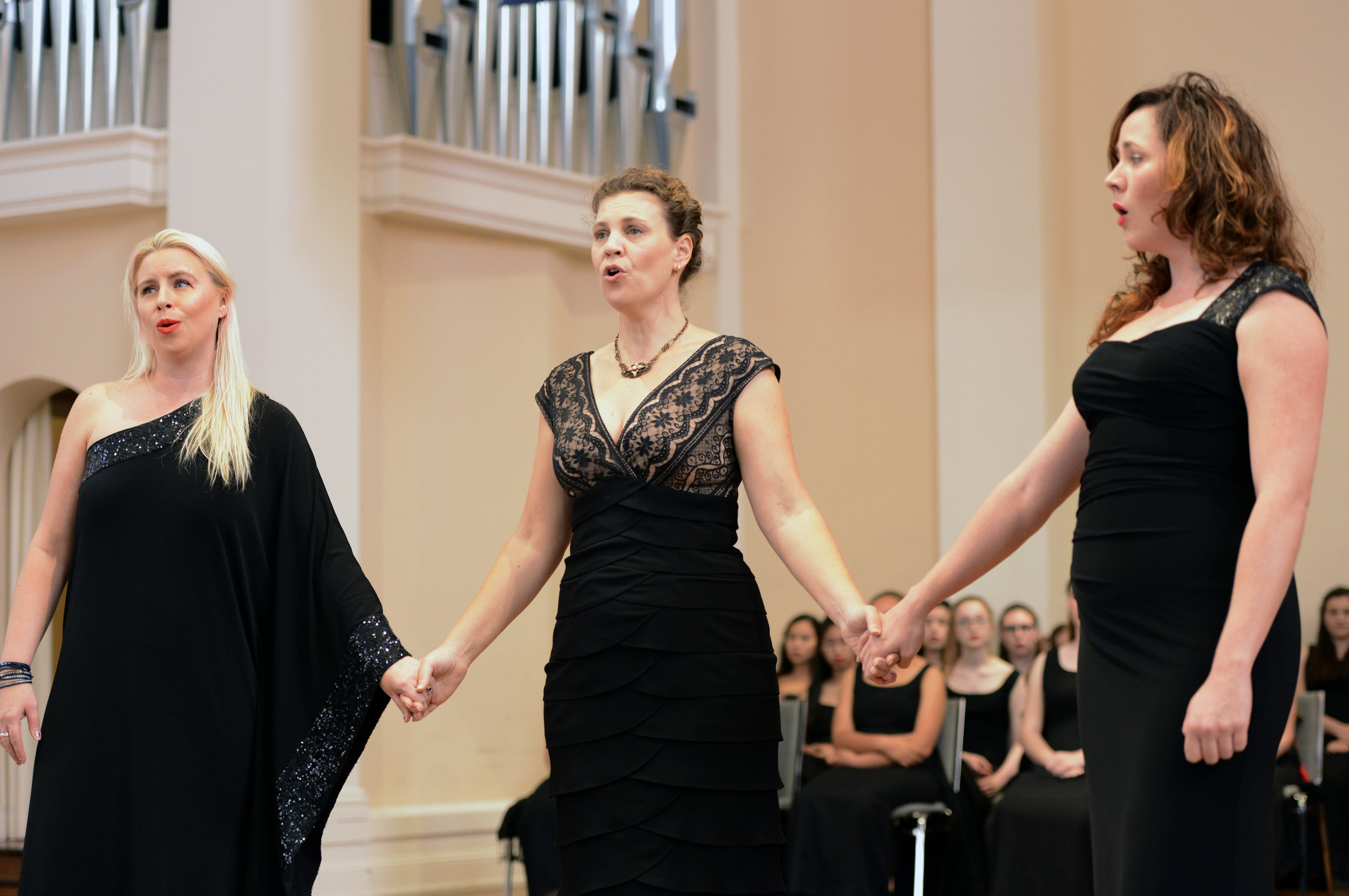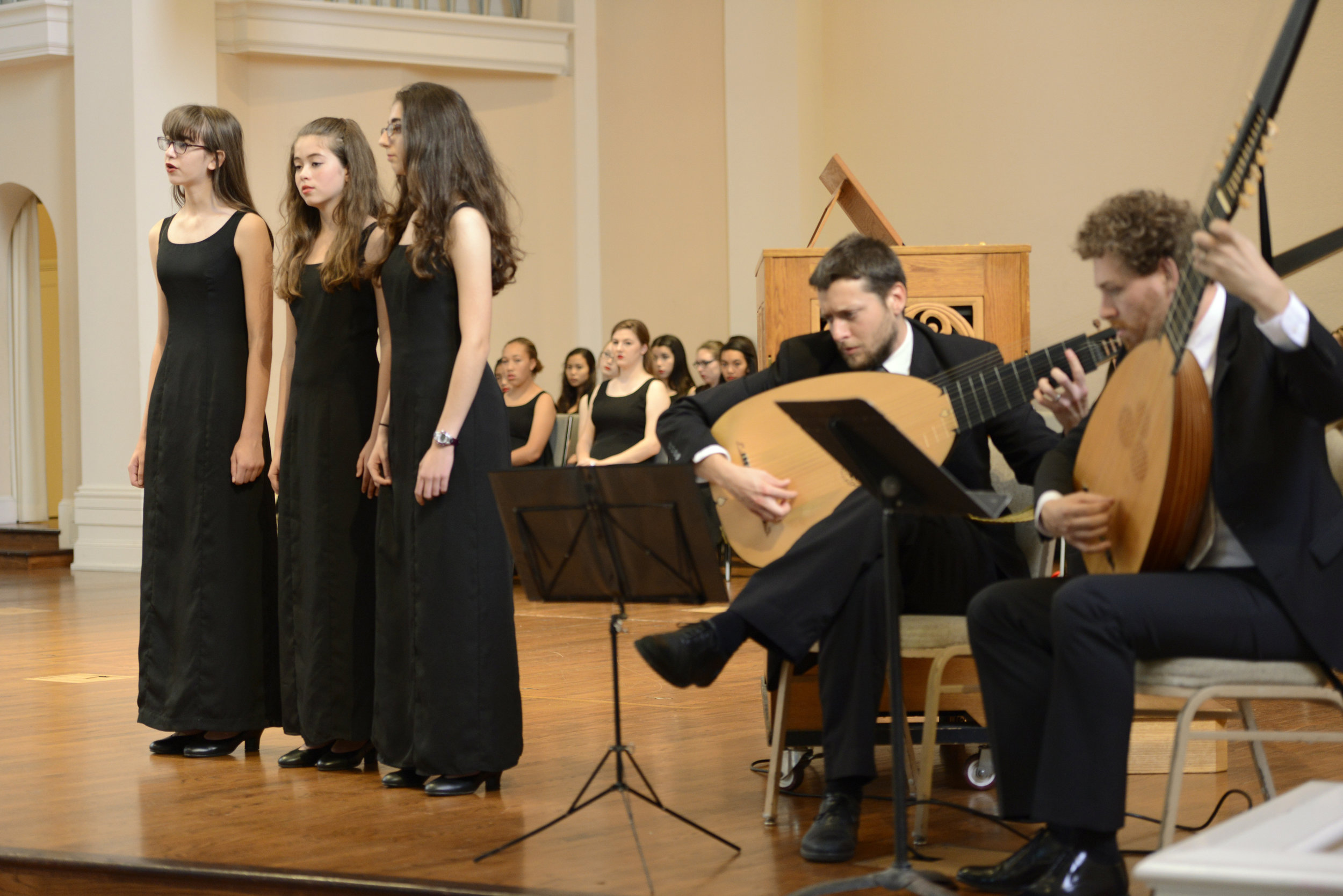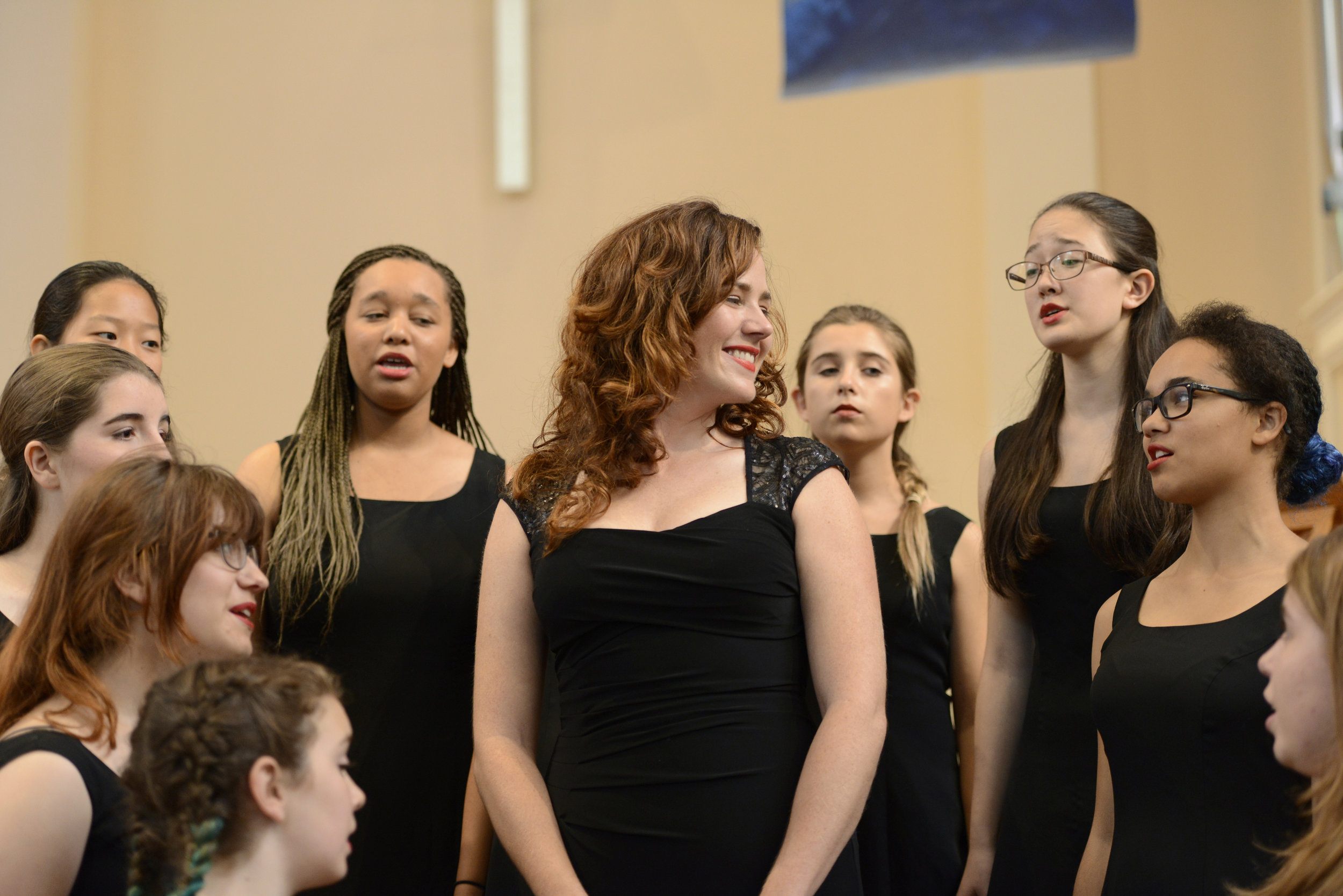Fall Happenings
Salutations SF Girls Chorus Community, Since the beginning of October, early music has been the only thing on our minds. The San Francisco Girls Chorus’s preparation for the collaborative concerts with the musical ensemble Tenet, which took place this past weekend, was an interesting and rewarding process. With the angelic harmonies created by the three talented women working with us and the creatively arranged staging directed by Charles Otte, these performances were beautiful opportunities to experience the wonders of early music composed by women of the convents. For both the audience and the performers, the concerts revealed how this special assortment of pieces would have sounded when sung by its first performers behind convent walls.

We began staging a week before the performances. Every minute was spent on the fine details of each performer’s movements and Charlie’s planning for subsequent songs seemed to pick up speed as the concerts neared. Charlie explained the main ideas and thoughts on which we should focus for each piece as he introduced the staging. He spent the most time on the first song that we would perform, O Virtus Sapientiae by Hildegard von Bingen, as it was the song that would set the tone for the entire performance. We imagined we were the women of the convent who sang these same songs and, reunited by the performance, we were seeing each other for the first time after hundreds of years. Charlie let us wave to each other as we sang in rehearsal, and we performed with greater emotion and vibrancy each time after.
The staging was a great contribution, not only to the performance in general, but to the quality of the performance. The staging was a new, fun challenge that allowed us to give a more intimate and interesting experience to the audience while creating a deeper connection to the music.

The three women of the Tenet ensemble, Jolle Greenleaf, Molly Quinn, and Virginia Warnken, joined us during the rehearsals leading to the performances. While we were acquainted with Tenet’s Artistic Director, Ms. Greenleaf, as she spoke with us about early music earlier in the season, we had neither met the other two members of Tenet nor sang with them before this week. In rehearsal, Greenleaf, Quinn, and Warnken created a sound unlike any I have heard before. Like the music they sang, they never truly stood still. They would move as they sang, grounding themselves while giving lightness, depth, softness, and power to the music where needed. Even during the most difficult pieces, the Tenet members harmonized with what seemed to be natural ease and confidence. Their voices floated throughout the venue like prima ballerinas.
Another rather impressive aspect of Tenet was their ability to have fun with the music and with each other while remaining extremely focused. The singers of Tenet and instrumentalists that worked with them would joke and poke fun at each other without losing sight of their performance, and the music became livelier and more interesting when they had fun with their parts. Seeing this in Tenet was a novel experience for us, providing a good example of how we could be as a tightly-knit group of performers. After singing with them for the first time, the music we had practiced through this month felt complete. We were amazed by their voices and excited for the upcoming performances with them!
I had the pleasure of interviewing the members of Tenet later on in the week. Artistic Director and soprano Jolle Greenleaf explained the concept of early music: “early music is considered music composed before 1750 or 1800 and earlier. So it incorporates all of medieval music, all of renaissance music, and all of baroque music.”
 When I asked what drew them to early music, each of them had different reasons. Quinn explained that her upbringing influenced her choice to sing early music, as her “father is an organist and choir master, so I grew up really exposed to the music of Bach.” Greenleaf emphasized the appeal of the historical aspect that comes with early music, commenting that, “There was so much music composed during this time that it felt like a really good fit and one that also lent itself well to being research-oriented…There was a whole scholarly element that I really enjoyed.” Mezzo-soprano Virginia Warnken spoke about her fondness for the details of the actual repertoire: “I’ve always been drawn to the sound and the textures. I love the active blending with sopranos and because a lot of it is equal-voice singing, I get to use a larger range of my voice than I usually do.”
When I asked what drew them to early music, each of them had different reasons. Quinn explained that her upbringing influenced her choice to sing early music, as her “father is an organist and choir master, so I grew up really exposed to the music of Bach.” Greenleaf emphasized the appeal of the historical aspect that comes with early music, commenting that, “There was so much music composed during this time that it felt like a really good fit and one that also lent itself well to being research-oriented…There was a whole scholarly element that I really enjoyed.” Mezzo-soprano Virginia Warnken spoke about her fondness for the details of the actual repertoire: “I’ve always been drawn to the sound and the textures. I love the active blending with sopranos and because a lot of it is equal-voice singing, I get to use a larger range of my voice than I usually do.”
Greenleaf also spoke with me about early music’s place in our culture today: “It’s taken a little while for our country to sort of get the bug, so to speak, about early music. But one of the things I find so interesting and different about what we do in early music versus the larger, main-stage opera and big, orchestra concerts is that it’s really music that is more appropriate for chamber spaces…that in itself limits the number of people that can attend a particular event. It means that we have to have a slightly different structure. Maybe we do it more times and people come and have that intimate experience versus doing it once for a really big crowd. So, I think it’s as valid in terms of being a repertoire that’s worthy of our time and attention, but I’m not sure that it’s designed in the same way. But

nowadays… So many things are done on YouTube or done in video context and because of that, it might mean that early music has a big resurgence because it feels very intimate and personal even though it’s not in the same room.”
Quinn concluded the interviews with more information regarding the lives of women who performed and wrote music in the convents. She describes, “They were like stars, but they lived very fearful lives because they were performing music in secret and the alternate side of that is the nuns, who nowadays we think are cloistered, had a very rich life there...I think you hear that in the virtuosity.”
All three women seem to share the opinion that the women of the convents were just as strong and powerful as some of our great performers today. I really enjoyed speaking with these talented and intelligent women. They gave me a better understanding of the music, the lives of the women who wrote and sang the music, and their motives and feelings while creating the repertoire.

Mission Dolores in San Francisco held our first performance. With a large dome looming above the audience, the beautiful acoustics allowed our voices to ring clearly throughout the church. Our second concert took place in the First Congregational Church in Berkeley, a smaller church lit by the warm, afternoon sun peeking through detailed, stained-glass windows. In both performances, we caught the attention of our audience members with the ephemeral O Virtus Sapientiae and held it all the way to our energetic and fun encore piece, Chiacona di Paradiso, e d’inferno. Throughout the concerts, Greenleaf, Quinn, and Warnken sang with beauty and power, working alongside the San Francisco Girls Chorus. We serenaded the audience with songs of love, death, and religion. Seeing the enjoyment and awe of the audience, performing these emotionally vibrant pieces was a beautiful experience.
As modern-day young women, I feel that we are fortunate to have the opportunity to be a part of the revival of this music from long ago. This is one reason among many as to why we are incredibly grateful that we can sing to so many different groups of people in all the different places and ways we do. We have music of all different kinds at our fingertips and people at each performance waiting to hear what our voices, our minds, and our hearts have to express. As performers, what more could we ask for?
Viola Yasuda San Francisco Girls Chorus, Alto I
